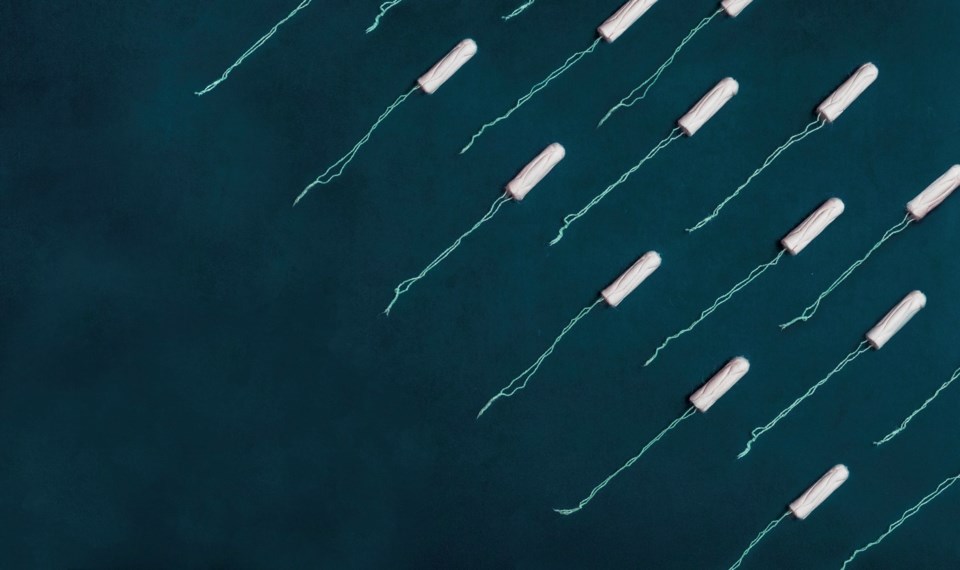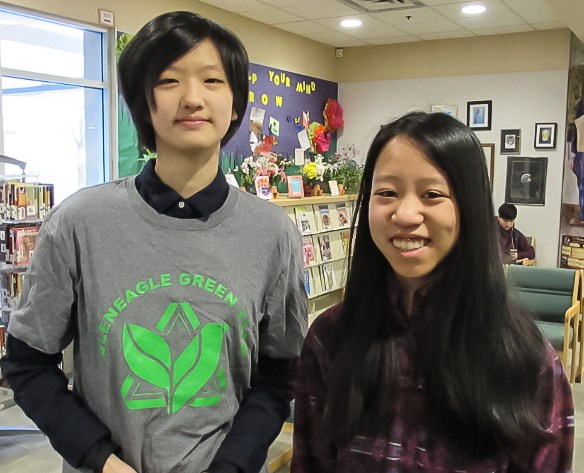Two Gleneagle secondary students have won first place in a competition investigating solutions to plastic pollution in communities across Canada.
Grade 11 student Diane Huang and grade 12 student Janelle Feng picked up the first place awards for two stories, Huang for her article on the disposal of feminine hygiene products, and Feng for her video on responsible shopping.
The awards were presented by the Young Reporters for the Environment program, an international network of young people in 25 countries that looks for solutions to environmental problems through investigative reporting, photography and video journalism.
Congratulations to our club members Diane Huang and Janelle Feng for their first place wins as part of @envirodefence Canada's #YoungReportersForTheEnvironment 2019 National Competition! See their work on https://t.co/jIHx5gEXEj. @GleneagleSD43
— Gleneagle Green Team (@GreenGleneagle) April 25, 2019
The two high school students first heard about the competition through the ‘Green Team,’ a student environment club whose members usually fill their time on gardening and raising awareness around environmental issues like recycling.
For Huang, a longtime member of environmental clubs who began writing for the school’s newspaper last year, the contest provided a perfect opportunity to marry her interest in writing with concern for the environment.
“I’ve always found the environment was more important to me than politics or economics,” she said. “Without the planet there would be no economy, it wouldn’t matter if stocks were rising or falling. If you can’t breathe then what’s the point.”
Huang first started thinking about how feminine hygiene products impact the environment last year when the UK put in place a ban on a variety of single use plastic products. She thought to herself, “If they’re banning straws and cotton swabs, how come they aren’t banning single use menstrual products?”
“I wanted to bring awareness to this,” she said. “Help people who could change.”
But when Huang submitted her article, she never thought anything would come of it. Then she got an email from the non-profit Environmental Defence saying she had won.
“I jumped out of my chair, I was really excited. I shouted. I was just shocked. I was at a loss of words that I would win a competition,” said Huang.
As the win sunk in, Huang said she started to feel something more lasting.
“It felt good that something close to my heart would be out there for people to see and talk about,” she said. “It’s not easy to talk about these topics like it is for plastic water bottles.”
In writing about tampons, pads and the impact their disposal has on the environment, Huang said she hopes to be part of a wider push to challenge people’s aversions to reusable feminine hygiene products.
“It’s hard to get people to wrap their heads around washing,” she said.
“They don’t won’t to talk about it. They don’t want to see the blood.”
See Diane Huang and Janelle Fang’s stories below.
A bloody problem—period
Diane Huang

It was only recently that Always changed their packaging to cardboard boxes from plastic bags. A walk on the beach can be turned into a mournful march for the sea-creatures that are stranded among piles of disposable plastic. A swim in the ocean can reveal startling truths as garbage islands float closer. A city outing with friends can cause detours due to plastic litter in the streets.
These are just some scenarios of the horrors of single-use plastic items. Eighteen billion pounds of plastic ends up in the oceans each year. Don’t worry, there is hope to prevent any further suffocation from plastic trash.
Traditional focus on single-use plastic items is a good step and recently, cities across British Columbia are implementing “zero waste” strategies.
Yet, these strategies have missed another item that is perhaps even more prevalent than the to-go coffee cup. These elusive items are disposable feminine hygiene products. It is a risky topic that nobody wants to talk about.
But the figures disagree. According to the 2016 Coquitlam census, around 37,395 women of menstruating age live in the area. The average amount of years of menstruation is 38 years and the lowest average amount of tampons used is 8,000. To do the math, at the lowest numbers, that would be 7,872,632 tampons used a year in Coquitlam alone.
This just an estimate, but to think that over seven million tampons will end up in the landfill in one year from one small city is shocking. However, Tampons like to walk away from landfills and end up on beaches, as the British newspaper The Guardian found. It reported that the Marine Conservatory estimates 20% of a hundred meters of shoreline is covered in trashed personal care items including tampons.
The calculation only uses tampons, but it is realistic to consider menstrual pads into the situation as well. Both items cannot be flushed down the drain and are made nearly entirely out of plastic or semi-synthetic materials. At least dioxins, which are harmful to the environment, are now banned from bleaching processes. But is that enough?
Single-use menstrual products are a plasticky mess of packaging and finicky components. Many brands such as Kotex still package in plastic bags, which affect the planet in ways that need not be mentioned. Other brands have moved on to cardboard boxes, but their contents are still wrapped in plastic. Still, menstrual pads have a plastic backing and waxed paper strips.
The most popular brand of tampons in Canada, Tampax, uses a cardboard box, but depending on the type of tampon, the entirety of the tampon could be made out of plastic. Take Tampax Pearl for example, the applicator is plastic with colour, the core is “cotton and/or rayon”, and the string is “cotton with propylene braid.” The list doesn’t include the fabric surrounding the core which is “polyethylene and polypropylene” and the thread which is polyester. Its sister brand, Always, has less plastic but still contributes to landfills like all disposable sanitary napkins.
“I have a huge problem with the packaging that goes into single use female hygiene products,” commented Carmen Kim, a student at the University of British Columbia.
For many, it is a problem, but not enough to warrant a solution. This is due to gender norms for the female population that have been set by men. Menstruation is often seen as “dirty” and menstrual items tend to be discreet because of that reason. Most women are afraid of men realizing their bloody secret.
It is still possible to change the habit. Instead of conventional pads or tampons, try to find plastic-free pads and at least applicator free tampons. They often use organic cotton as well. Many women have found success with Natracare, which offer plastic free tampons and pads. If switching is not possible, even using a reusable tampon applicator such as the ones that Thinx sells is also a good exchange. Menstrual subscriptions such as Blume and Cora deliver organic, plastic free disposable supplies to the doorstep.
For those willing to take larger steps, consider washable options such as period underwear, menstrual cups and cloth pads. Vancouver based and made Lunapads are also B-Corp certified, ensuring ethical and sustainable practices. Finnish company Lunette, British company Mooncup and Canadian company Diva Cup all make menstrual cups in several sizes and are compliant with local health authorities. Canadian brand Knix and American Thinx make period underwear that can hold up to two tampons’ worth of menstrual fluid.
Switching to reusables or plastic-free will reduce plastic in the beautiful waterways of British Columbia and save money. It is commonly known that reusables can last as much as ten years. The initial cost is large, but worth it in the long run.
“I am getting [resuables] soon because the amount of waste created by single use pads is lucrative and the price is worth it considering I can use them for a longer period of time than just the regular pads I use now!” said Kim before she purchased Lunapads.
Plastic packaging in grocery stores
Janelle Feng
>



